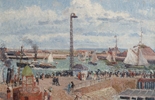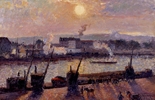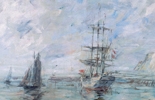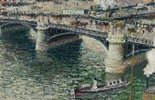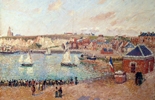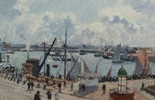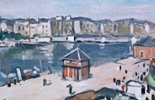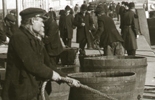Pissarro dans les ports
from April 27 to September 29, 2013
Pissarro finished his harbours series in Le Havre in 1903. Maxime Maufra carried on the Impressionist tradition during his 1905 stay. But already, young artists who had followed in their elders' footsteps and begun their careers in the same places were exploring other artistic avenues.
Raoul Dufy, who grew up in Le Havre, painted his first views of the harbour just before 1900, in a style that was still influenced by Eugène Boudin. 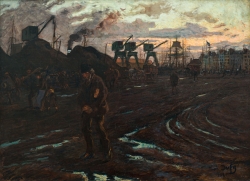 But he showed a radically different work, imbued with social realism, at the 1901 Salon des Artistes Français. Recently rediscovered and acquired by MuMa, Fin de journée au Havre (End of the Day in Le Havre) offers a sombre vision of the harbour landscape at its most industrial: the wharf where coal is unloaded, the silhouettes of the first electric cranes, and above all the crowd of dockers finishing work at the end of their day. Painted in a context of troubled labour relations, the picture is something of a manifesto. But this flirtation with Realism was to be brief: Dufy was soon off on a new track.
But he showed a radically different work, imbued with social realism, at the 1901 Salon des Artistes Français. Recently rediscovered and acquired by MuMa, Fin de journée au Havre (End of the Day in Le Havre) offers a sombre vision of the harbour landscape at its most industrial: the wharf where coal is unloaded, the silhouettes of the first electric cranes, and above all the crowd of dockers finishing work at the end of their day. Painted in a context of troubled labour relations, the picture is something of a manifesto. But this flirtation with Realism was to be brief: Dufy was soon off on a new track.
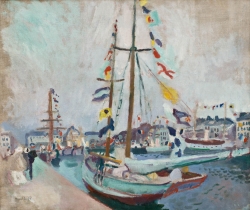 At the moment when Pissarro arrived in Le Havre, the young artists seem to have been moving in another direction. Dufy abandoned his "dark manner" and all of them began to use a lighter palette, permanently abandoning their Realist leanings in favour of explorations of colour.
At the moment when Pissarro arrived in Le Havre, the young artists seem to have been moving in another direction. Dufy abandoned his "dark manner" and all of them began to use a lighter palette, permanently abandoning their Realist leanings in favour of explorations of colour.
When the scandal of Fauvism broke at the Salon d'Automne of 1905, Dufy abandoned all visual reference to Impressionism. He gave up attempting to recreate observed reality, opting instead to reinvent it. "Painting means making an image appear that is not the image of/ the appearance of things, but which has the force of their reality," he wrote. This transposition of reality was brought about by means of arbitrarily chosen colours, applied flatly or in broad brush strokes of pure, dazzling colours that heightened each other's impacts.
Dufy gradually forsook industrial sites for the beach and the sea. Bathing scenes and regattas became favourite subjects, and were to feature in his pictorial repertoire until the end of his life. When he returned to the harbour, it was to walk along the historic docks and offer a colourful artificial vision of the landscape, in which the human presence would increasingly be reduced to a few silhouettes.
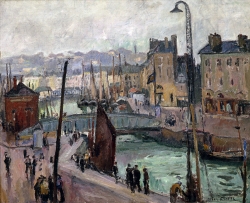 Othon Friesz and Albert Marquet accompanied him in this venture. The harbour scenes they painted together in Fécamp, Le Havre and elsewhere on the coast of Normandy in 1905 and 1906 show how far they had moved away from earlier influences, barely three years after Pissarro's stay in Le Havre−a break with the past that eventually led them to espouse Fauvism.
Othon Friesz and Albert Marquet accompanied him in this venture. The harbour scenes they painted together in Fécamp, Le Havre and elsewhere on the coast of Normandy in 1905 and 1906 show how far they had moved away from earlier influences, barely three years after Pissarro's stay in Le Havre−a break with the past that eventually led them to espouse Fauvism. 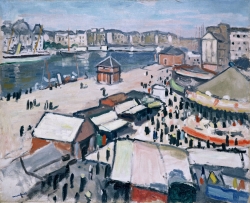

Raoul DUFY (1877-1953), End of the Day at Le Havre, 1901, oil on canvas, 99 x 135 cm. . © MuMa Le Havre / David Fogel — © ADAGP, Paris, 2014

Raoul DUFY (1877-1953), Yacht with Flags at Le Havre, 1904, oil on canvas, 69 x 81 cm. . © MuMa Le Havre / David Fogel © ADAGP, Paris, 2013
When the scandal of Fauvism broke at the Salon d'Automne of 1905, Dufy abandoned all visual reference to Impressionism. He gave up attempting to recreate observed reality, opting instead to reinvent it. "Painting means making an image appear that is not the image of/ the appearance of things, but which has the force of their reality," he wrote. This transposition of reality was brought about by means of arbitrarily chosen colours, applied flatly or in broad brush strokes of pure, dazzling colours that heightened each other's impacts.
Dufy gradually forsook industrial sites for the beach and the sea. Bathing scenes and regattas became favourite subjects, and were to feature in his pictorial repertoire until the end of his life. When he returned to the harbour, it was to walk along the historic docks and offer a colourful artificial vision of the landscape, in which the human presence would increasingly be reduced to a few silhouettes.

Othon FRIESZ (1879-1949), Le Havre, Bassin du Roy, oil on canvas. © MuMa Le Havre / Florian Kleinefenn

Albert MARQUET (1875-1947), Le Havre Fairgrounds, oil on canvas. © Bordeaux, musée des beaux-arts


